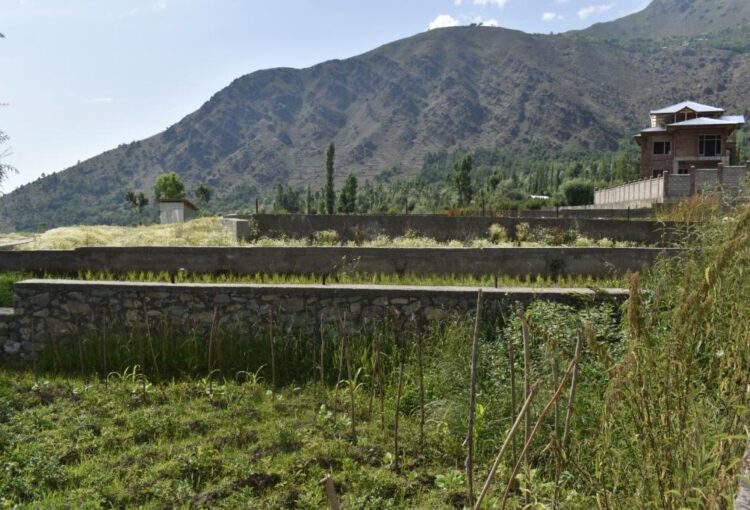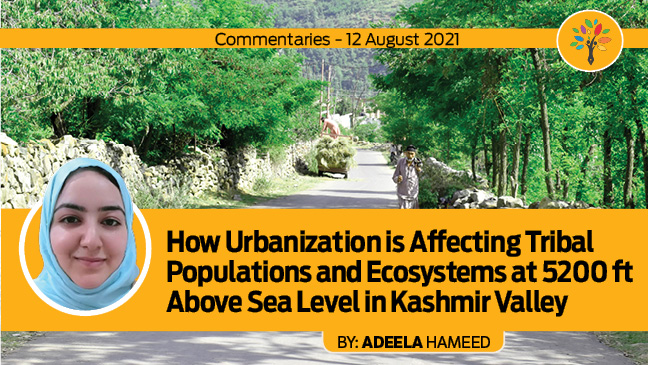With the rising population and the continuous decrease in residential land, the people of Srinagar are building houses in the outskirts of the city, the most pristine and ecologically rich regions. Dara, a small village nestled in the Zabarwan range of the Hindukush Himalayas located in Kashmir valley, is one such region, located towards the periphery of Srinagar city, which is currently witnessing rapid urbanization.
This commentary focuses on tribal communities living in Dara, a small village nestled in the Zabarwan range of the central part of Kashmir valley, with special emphasis on how urbanization is affecting both, indigenous people and ecosystems around the area.
The population growth of Srinagar city during the last century (1901-2011) has been phenomenal. The population increased from 0.122 million persons in 1901 to 1.225 million persons in 2011, indicating nearly a tenfold increase. This amounts to 900 percent growth with a net increase of 1.103 million persons.
After 1961, a new phase of growth commenced. The population of the city increased from 0.285 million persons in 1961 to 0.606 million persons in 1981, recording a net addition of 0.320 million persons with alarming decadal growth rates of 34.31 and 40.13 percent, respectively. The main factors responsible for this accelerated population growth during this period have been in-migration, increase in birth rates and a fall in death rates. Besides this, the merger of 62 villages to city limits in 1971 and the introduction of the urban agglomeration concept, which brought a number of rural areas under the jurisdiction of Srinagar city, are the other factors contributing to the rapid growth of population.

The outer wards of Srinagar city, like Dara, have a comparatively low crowding index (below 5.56 persons per km2). The main reason is their recent origin. These wards form part of the outskirts of the city where a significant proportion of land is still vacant or devoted to agriculture and horticultural activities. These wards are inhabited by rural communities who had been living there before the expansion of city limits. Also, occupying the wards are the newly migrated business class people and high-ranking government officials. They have migrated from either the highly congested city core areas in search of better environmental conditions or from the rural areas to get access to various urban facilities. Thus the land-use pattern changed drastically over the past decades. And after the 2014 floods in Srinagar, people living in the-then affected areas gradually decided on shifting to higher reaches, mostly towards Zabarwan hills, for protection against floods. This trend eventually led to an increase in residential colonies in once-pristine ecosystems, such as Dara, in less than a few decades.

While traveling to Astan Marg, a beautiful meadow located near a famous Sufi shrine in Dara, the author captured some photos to show how urbanization has changed the topography of the place.
Increased footfall has decreased forest cover, which has a higher chance of changing regional precipitation periods in the future – thus contributing to one of the many effects of climate change. This shift has affected the livelihood of tribal communities, those who had been sustaining their families and food in Dara for centuries.
One resident, Ashraf Ahmad aka ‘Kaka’ from Astan Marg explained how recent developmental projects have affected the rural population around his neighborhood. He said: “We were considered as one of the far-flung regions of Kashmir Valley. But now due to rich people investing in our land, we are a great catch in the real estate domain. The young Gujjars living around in our area are keen on selling their ancestral properties for monetary benefits and improved living conditions.”
With young adults among the Gujjars and Bakarwal communities adhering and aiming for a modern living standard, the older generation has been left with two choices: stay and maintain their way of life or sell their land and relocate to some other place with their children. The latter becomes a herculean task for most old-aged indigenous people as being able to adapt to a new environment upon immigrating is tough.
One woman resident of Astan Marg spoke about amenities that are available due to the emergence of new colonies in the region and her children’s decision on working in the city. She said: “When people from the city buy land or property here, we are benefited as well. In the form of better roads, electricity, grocery supplies, medical assistance and education. Increased footfall has resulted in more benefits than losses. On the other hand, our children want to live in cities and work there. So for them too, we sell our properties.”
However, this phenomenon has greatly affected the indigenous way of life. Their traditions and agricultural practices have been surrendered to concrete jungles, leading to the loss of a century-old culture.
Humans are an indisputable part of forests. With some exceptions of extremely inaccessible forest regions, all forests present on Earth have been influenced by humans since the onset of civilization. Forest communities have, thus, never been without the influence of human activities. More than 1.6 billion (25%) people of the world are dependent on forest resources for their livelihood. However in India, out of 1.3 billion people, about 64% of the rural (0.5824 billion) and 100 million of the tribal population (0.1 billion) depend on forests for their sustenance. We understand cause and effect due to amassing an increasingly deep body of knowledge about forest processes over more than a millennium, thus human influences simply cannot be likened to the blind forces of nature. We can’t say that we didn’t expect the result to be what it is now.
Talking about Dara, as is true for all pristine forest ecosystems, human colonization has led to a number of changes in its distribution and spread. The effects seen from over-exploiting forests around Dara are, and could be even more, devastating. For example, increased footfall has led to a reduction in air quality, motorable roads have paved the way for disturbances in wild floral and faunal habitats, and increased construction of residences/hotels has decreased the total forested area when compared to a decade ago.

Jammu and Kashmir’s forest area is below the standard prescribed by National Forest Policy. The policy states the total forest area in hilly regions, like Jammu and Kashmir, should be 66% of the total land area. Official figures reveal that only 50.97% of the area is under forests. Of the total forest area of 20,230 sq km in the erstwhile state, Kashmir has 8,128 sq km, Jammu 12,058 sq km area, while Ladakh has the remaining area.
The effects of deforestation and unchecked urban development might not be as adverse or rampant now, with the natural environment constantly modifying negative impacts, however, how long do you think it would take for Dara to become another concrete jungle? Just a thought!
Although development is necessary and with the population on the increase, people have to find a way and place to live comfortably, but not at the expense of the environment. Everything, as mentioned earlier, has a cause and effect. And by limiting the breathing space of our environment today, we might lose precious air in the future.
Most people the author talked to were satisfied with selling their properties to the rich, well-off upper class from the city. Why? Because, for them, human development is unequivocally necessary. Nobody can blame them. Plenty of people agree to urbanization in this shy Dara locale. But ecological perspective is something that a layman cannot easily understand. For him/her, facilities for family and society gain precedence, which is understandable. Nevertheless, it is not difficult to notice that Dara has unfortunately lost its forests and with them, habitats that could have been successful. Once again, we are at an impasse. Because when everything is at stake, the cost of human life, compared to a pristine habitat, is more important.
Recommendations
Forest systems transcend disciplinary boundaries. Their successful management will require cross-discipline collaboration and a complete understanding of their complexity. We know that forests are interconnected systems, with tangled inter-dependencies. Thus, it becomes even more complex to unravel an idea that might seem simple superficially but might have a tremendous impact on how human-forest balance can be maintained. Some of which are:
- Afforestation strategies that attempt to replace lost ecosystems can result in excessive water demands and shortfalls for society;
- Banning products that drive deforestation can negatively impact people who depend on the industry;
- Small-scale, selective logging can fragment forests and expose edges that bleed carbon and biodiversity.
What more can be done to maintain the human-forest balance?
- Educating the people. The first and foremost aspect of conservation is awareness. Understanding the importance of our ecosystem and sustainable development is mandatory for everyone. For communities that thrive and survive on forest produce, awareness regarding striking a conservation balance takes utmost importance. Similarly, when selling land to development babus, a deal to maintain the ecosystem around the property and take care of garbage disposal must be made at the outset, before anything else.
- Agroforestry is one approach that seeks to manage forest services and agriculture together. While such projects will not fully replicate the benefits of the original forests, they can be a compromise in regions where the livelihoods of local landowners depend on productive land.
- Socio-economic disciplines have helped devise policies to protect existing forests while supporting local economies. One such policy is payments for ecosystem service (PES). These schemes offer financial incentives for landowners to protect and manage their forests, thus allowing extended societies to benefit from their carbon capture, water management, and biodiversity. Those intending to build structures, whether residences or resorts in Dara, must make sure to invest time and effort in such schemes.
Many questions remain regarding the success of these projects, and continuing research seeks to improve these schemes to benefit both humanity and forest ecosystems.
- The author is Visiting Fellow at Jammu and Kashmir Policy Institute
References
- https://www.yourarticlelibrary.com/environment/forest/forest-resources-in-india-use-over-exploitation-causes-and-effects/28196
- https://www.thenorthlines.com/despite-huge-forest-department-thousands-kanals-forest-land-remains-encroachment/
- https://www.nature.com/articles/s41467-018-03586-1
- https://academicjournals.org/journal/JGRP/article-full-text-pdf/B68D96056832
- https://www.researchgate.net/publication/329394150_Livelihood_of_Two_Local_Communities_and_Their_Dependence_on_Forest_Resources_A_Case_Study_from_Western_Himalaya_Dachigam_National_Park_Jammu_Kashmir_India
- https://www.greaterkashmir.com/more/jks-forest-area-shrinking








Leave a Reply
You must belogged in to post a comment.